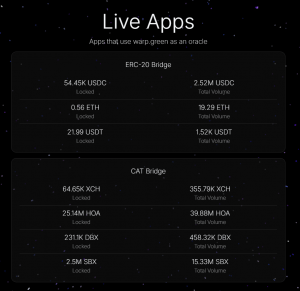Peer-to-Peer is a series of Q&A style interviews with members of the Chia community. This interview is with Yakuhito, creator of the TibetSwap AMM and warp.green bridge.
- Twitter: @yakuh1t0
- Blog: FireAcademy.io
Hi Yak, thank you for taking time to chat today. Let me start by just saying what a cornerstone you have been for the community from launching the first AMM (TibetSwap), to building the popular warp.green bridge, to designing a new way to build dApps with slots, to leading development of recent innovations such as the streaming puzzle and staking mechanisms.
We‘ll get to all of these projects but first I need to know, how do you find time for all of these projects while also being a full time student?
Thank you for having me!
The people that know me well would certainly describe me as a hard worker. When an interesting project grabs my attention, my schedule rearranges itself to allow me to work on that project as well – even if it initially seems full. Having exciting/challenging projects is my ‘secret,’ if I have one.
I think that my Chia projects and my coursework are complementary. I enjoy both, and they’re different enough that I can concentrate on one when I want a break from the other. What’s important, at the end of the day, is to do something you’re passionate about – that way, you don’t feel exhausted after a full day.
What is it about Chia and the ecosystem that has kept you excited and building?
I joined the Chia community around 4 years ago. Like many community members, I started farming just after mainnet launch. I continued to read more about Chia, and, not long after, I started building yakuSwap, probably the first community-developed dApp. It allowed people to trustlessly trade assets cross-chain – at first between Chia and its forks (I added Ethereum support a bit later). You can think of yakuSwap as ‘cross-chain offers.’ While it won me 2nd place in the Sirius Labs Hackathon, I came to the realization that the project will probably not take off due to the requirements posed on users during the trades (both parties needed to be online at the same time for about 15-45 minutes).
I’ve had many such ‘experiments’ in the years since I’ve started developing on Chia. Most of them didn’t really work out, but some – like TibetSwap – had a great impact on the community (which I’m extremely proud of).
The main thing that keeps me building on Chia is simply its unique approach to blockchain architecture – the coinset model (there are, of course, many other reasons, but this is the main one for me). Development is so different on Chia that we basically need to re-think every dApp from the ground up – we can only borrow high-level design details and invariants from other blockchains, and, in some (rare) cases, those are not the best way to do things either. I find it extremely exciting that I get the opportunity to help build a chain’s Decentralized Finance infrastructure from scratch.
Speaking of DeFi infrastructure, at Chia Toronto 2025 you presented a keynote where you announced the next version of TibetSwap with CAT-CAT pairs and concentrated liquidity pools. How is that coming along? Do you expect it to replace or supplement v2?
I expect the new version to replace TibetSwap v2 – full range liquidity is a special case of concentrated liquidity where you supply liquidity for all prices (which, counter-intuitively, can be done efficiently – supplying liquidity has roughly the same cost, no matter what the range is).
I would say the project is advancing, but slowly. The design I covered is still the ‘ideal AMM’ in my opinion, but requires a lot of tech we haven’t seen on Chia yet. Development is progressing in small increments, each being rigorously tested/reviewed. This is a dApp I want to develop very carefully.
I am eagerly looking forward to the next version of TibetSwap. It’s certainly going to be a very complex dApp, and this approach ensures it’ll be as secure as possible.
How do you think of an AMMs role in Chia where emphasis has been on offer file order books and future support for partial offers?
This is a great question – (I’d like to point out to the readers of the article that Slowest Timelord asked this question about two weeks before TibetSwap announced partial offers).
To put simply, my thesis is that offers will be mostly used by ‘professional’ market-makers, while AMMs will be the place where the average blockchain user goes to provide liquidity. We’re heading to what I think is the best version of both, given the new version of TibetSwap and my recent CHIP for partial offers.
Lastly, I predict that most traders will not care about AMMs vs. offers – aggregators will route trades through both ‘worlds’ to get the best price.
Pivoting to another project of yours, it seems to me that warp.green has been humming along and working perfectly with over $5M in bridged volume. What’s next for warp.green or do you consider that project “complete“?

I’m happy that warp.green has been going so well – over the last year, bridging became a vital part of the ecosystem. The wUSDC.b stablecoin became a core component of on-chain trading, and I’m looking forward to its future uses in Chia-powered apps.
A good friend of mine told me a few years ago that a software project can never be truly finished, and I agree. There are certainly a lot of nice-to-haves that I haven’t gotten around to just yet. It’s great that welcome kits are online – they sponsor transactions from Base/Ethereum going to fresh Chia wallets (and meeting some other anti-abuse criteria). It’s a great onboarding tool, and I see several sponsored transactions pretty much every day.
While on the topic, I’d like to thank the other 10 validators for making everything possible. Being a validator is a demanding job that requires prompt responses. Their work is mostly pro-bono for the good of the community.
In my eyes, one of the most significant innovations in Chia app development has been your proposed action and slots way of solving for uniqueness and state. These back a couple projects you’ve teased, XCHandles and CATalog. How are these projects going and what ecosystem problem are you expecting these to solve?
Both projects are going well. There have been multiple (major) revisions for both XCHandles and CATalog as a result of testing and private feedback from a few community members. I want the community to get the best possible version of XCHandles/CATalog, and I’m going to share a lot more soon.
In terms of functionality, XCHandles, at its core, allows users to register handles and receive payments to them. It’s a lot easier to send funds to ‘@yak’ than to a Chia address, and the address is entirely resolved from the blockchain, making it very secure. CATalog solves a problem that’s mostly ‘invisible’ to most users – getting CAT details such as name, image, and so on. It’s an on-chain registry for these details, giving CAT creators control over their entries while a second layer still allows frontends like TibetSwap to hide some CATs that may be intentionally misleading.
One last thing I’d like to point out is that these apps were not possible until recently – I’d like to nudge the readers that are interested in more details towards the blog posts I wrote on that topic a while ago: https://blog.fireacademy.io/p/uniqueness-on-chain
Are there other projects that you think could make use of action and slots?
Yes, I think slots and the action layer will become fundamental building blocks for most if not all future apps running on Chia. The primitives changed the way I think about decentralized applications on Chia, and made them much easier to develop as they take care of a lot of common tasks ‘under the hood.’ They also allow much more complex dApps to be developed. I’m convinced we’ll see an explosion of new apps that leverage the action layer and slots in the near future.
In terms of other ‘under the hood’ challenges, do you think concurrency on a coinset model is something that needs to be solved? Do you have any ideas to address this?
The coinset model is a new approach to blockchains, and there are certainly topics that need to be figured out. This is one of them – as we get more people using Chia, concurrency will become more and more important. I think, eventually, we’ll get to what I call ‘private mempools’: a collection of app-specific mempools that will complement the existing mempool, with farmer software subscribing to everything and building a block with all the available information.
By the way, congratulations on your recent win of the CircuitDAO audit competition, beating out 14 other developers!. I read your blog post documenting your findings and experience. What are your thoughts on the accessibility of developing on Chia? Do you think there’s a lack of Chialisp developers and how can we solve for it?
Developing on Chia is becoming easier and easier thanks to the efforts of its developer community. A lot of effort is going into improving tooling and generating examples for future Chia developers. Keeping up with updates such as new apps, the action layer, or chia-wallet-sdk may as well be a job on its own – and that’s a good sign, as the developer experience is improving very fast.
I think it’s just a matter of time until the lack of Chialisp developers will ultimately be solved by Chia’s strong, growing community.
Thank you for taking the time to chat, is there anything else you would like to share with XCH.today readers?
I’ll be brief for this one: Thank you! A blockchain is nothing without its community.









